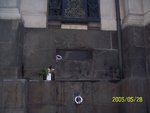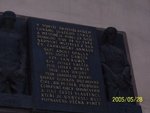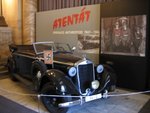seesul
Senior Master Sergeant
After France and Great Britain abandoned Czechoslovakia at Munich in 1938, it was only a matter of time before the now indefensible country was overrun. The country was transformed into the "Protectorate of Bohemia and Moravia", and then gradually referred to merely as "the Protectorate", thus subsuming the country into Greater Germany and destroying its national identity. In 1941 Reinhard Heydreich was appointed Reichsprotektor of the Protectorate. Heydrich was the head of the Sicherheitdienst, or SD, the intelligence-gathering arm of the Nazi secret state police (by rank an Obergruppenführer, or general), and Hitler's personal choice as his successor. Heydrich was particularly efficient in two tasks as Reichsprotektor - firstly, ensuring the productivity of the Protectorate's war economy (Bohemia and Moravia had been the main industrial belt of the Austro-Hungarian Empire), and secondly, in trampling what little local resistance existed. But he would later become the highest-level Nazi to be assassinated during the war.
Worried by Heydrich's successes in driving one of the most important parts of the Nazi war economy, the British had soon decided he had to go. The Special Operations Executive had been training teams of dedicated Czech patriots in Cheshire to parachute into their homeland to organise the underground resistance and assassinate the Butcher of Prague. This assassination was nicknamed Operation Anthropoid, and was the bravest and most decisive act to emerge from the Czech resistance movement - perhaps one of the most decisive in the whole of occupied Europe. A mere two months after Heydrich had moved to the Protectorate, in December 1941, a band of seven assassins parachuted into the country near the town of Lidice. Armed with British weapons and explosives, they quickly went underground and began intelligence-gathering. After spending five months building up a detailed picture of Heydrich's movements, they decided to strike.
On May 27, 1942, four of the men (Lt. Adolf Opalka, Sgt. Josef Valcik, Sgt. Jan Kubis and Sgt. Josef Gabchik) had finally found their opportunity. Heydrich, believing himself to have succeeded in pacifying the Czech population and expecting transfer to France soon, had taken to driving around his dominions in an open-topped, unarmoured Mercedes. This day found Heydrich being conveyed in such a manner through the suburbs of Prague, whilst his nemesis awaited near the Troja Bridge. Valcik and Opalka kept lookout waiting for the car to approach (one account has Gabcick's girlfriend keeping watch), and signalled to the others that it was without a military escort. As the car slowed to turn around a hairpin bend, Gabchik lifted his overcoat and opened fire with his Sten submachine gun. To his horror, the gun jammed, and Heydrich screamed to his driver to run the man down. Jan reacted quickly, realising what had happened, and tossed one of his modified anti-tank grenades at the vehicle. It failed to enter the open-topped car, but ripped through the right wing, embedding fragments of itself and the car into Heydrich's body.
As the Germans open-fired, the Czechs fled. Heydrich, barely able to walk, staggered out of the vehicle and collapsed on the bonnet. His driver was relatively unharmed, and Heydrich ordered him to pursue the men. He ran after Josef, the men duelling with their pistols as they went, and Josef was able to wound the man and escape. Heydrich was conveyed to a hospital in Prague, and Himmler sent his best doctors to try and effect his recovery. Although Heydrich's condition appeared to stabilise after a few days, he eventually died on June 4. The exact cause of death is not known - it could have been blood poisoning or, perhaps, poisoning. The turnaround in his health was so dramatic and the symptoms he displayed so akin to botulin poisoning that there has long been speculation that the modified anti-tank grenades contained the toxin. Although the files on the operation are still sealed, it is known that Paul Fildes, head of the Porton Downs research center that was developing BTX weapons, was involved in the pre-planing stages. He would later claim that the death of Heydrich was "the first notch on my pistol."
Meanwhile, the German reprisal was beginning. They pieced together evidence from the scene of the attack to identify resistance members, and accidently stumbled across a briefcase which contained details of Czechs who were soon to acquire false papers. They pounced on numerous members of the resistance and interrogated them, although some committed suicide to avoid capture. The Gestapo offered 10,000,000 Crowns for information leading to the capture of the assassins, and two of their own team - Sgt. Karel Curda and Cpl. Vilem Gerik - betrayed them. Holed up in an Orthodox Church on June 18, 1942, the Czechs made their last stand.
Germans stormed the Church, and the seven men (the four assasins, and Sgts. Bublik, Hruby and Svarc) holed up inside fought bravely with pistol, rifle, submachine gun and grenade. Opalka was killed in the firefight, and Kubis and Svarc fatally wounded. The other four men were hiding in the crypt, afraid to tunnel away for fear of giving away their position, although it might have saved them at this point. The Germans discovered they were in the crypt and tried to storm it repeatedly, first through the entrance hatchway and then by blowing up the stone entrance. The defenders acquitted themselves bravely, killing fourteen Germans and fighting until they ran out of ammunition, and the Nazis began to flood the crypt through its sole ventilation hatch. At this point they committed suicide with their revolvers.
Horrendously, this was not the most brutal of the reprisals carried out by the Nazis for the death of Heydrich. On June 8 they had surrounded the village of Lidice, and placed all the men aged over 16 in a barn. The next day they were shot, and the women and children were sent to Ravensbrück concentration camp. The village was destroyed and removed from German maps - but placed on others as villages around the world renamed themselves Lidice to commemorate the senseless destruction. The Nazis declared that for every further act of "Jewish terrorism" they would kill hundreds of Jews in their custody, and the total death toll for the reprisals is estimated at 1,300.
Like many of the men and women involved in the resistance movement in occupied Europe, the ones lost in Prague were among the finest their country had to offer. They are justly remembered be memorials in the Czech Republic and Great Britain. A monument to the children of Lidice was created by a survivor, made out of the melted-down remains of statues of Lenin and Czech Communist leaders. The crypt is now a museum in Prague, and anthropod reports that is is very moving to visit.
Source: Operation [email protected]
BTW, one of the Czech soldiers, Josef Valcik, was born and grew up in a small village few miles away from my born town...
Worried by Heydrich's successes in driving one of the most important parts of the Nazi war economy, the British had soon decided he had to go. The Special Operations Executive had been training teams of dedicated Czech patriots in Cheshire to parachute into their homeland to organise the underground resistance and assassinate the Butcher of Prague. This assassination was nicknamed Operation Anthropoid, and was the bravest and most decisive act to emerge from the Czech resistance movement - perhaps one of the most decisive in the whole of occupied Europe. A mere two months after Heydrich had moved to the Protectorate, in December 1941, a band of seven assassins parachuted into the country near the town of Lidice. Armed with British weapons and explosives, they quickly went underground and began intelligence-gathering. After spending five months building up a detailed picture of Heydrich's movements, they decided to strike.
On May 27, 1942, four of the men (Lt. Adolf Opalka, Sgt. Josef Valcik, Sgt. Jan Kubis and Sgt. Josef Gabchik) had finally found their opportunity. Heydrich, believing himself to have succeeded in pacifying the Czech population and expecting transfer to France soon, had taken to driving around his dominions in an open-topped, unarmoured Mercedes. This day found Heydrich being conveyed in such a manner through the suburbs of Prague, whilst his nemesis awaited near the Troja Bridge. Valcik and Opalka kept lookout waiting for the car to approach (one account has Gabcick's girlfriend keeping watch), and signalled to the others that it was without a military escort. As the car slowed to turn around a hairpin bend, Gabchik lifted his overcoat and opened fire with his Sten submachine gun. To his horror, the gun jammed, and Heydrich screamed to his driver to run the man down. Jan reacted quickly, realising what had happened, and tossed one of his modified anti-tank grenades at the vehicle. It failed to enter the open-topped car, but ripped through the right wing, embedding fragments of itself and the car into Heydrich's body.
As the Germans open-fired, the Czechs fled. Heydrich, barely able to walk, staggered out of the vehicle and collapsed on the bonnet. His driver was relatively unharmed, and Heydrich ordered him to pursue the men. He ran after Josef, the men duelling with their pistols as they went, and Josef was able to wound the man and escape. Heydrich was conveyed to a hospital in Prague, and Himmler sent his best doctors to try and effect his recovery. Although Heydrich's condition appeared to stabilise after a few days, he eventually died on June 4. The exact cause of death is not known - it could have been blood poisoning or, perhaps, poisoning. The turnaround in his health was so dramatic and the symptoms he displayed so akin to botulin poisoning that there has long been speculation that the modified anti-tank grenades contained the toxin. Although the files on the operation are still sealed, it is known that Paul Fildes, head of the Porton Downs research center that was developing BTX weapons, was involved in the pre-planing stages. He would later claim that the death of Heydrich was "the first notch on my pistol."
Meanwhile, the German reprisal was beginning. They pieced together evidence from the scene of the attack to identify resistance members, and accidently stumbled across a briefcase which contained details of Czechs who were soon to acquire false papers. They pounced on numerous members of the resistance and interrogated them, although some committed suicide to avoid capture. The Gestapo offered 10,000,000 Crowns for information leading to the capture of the assassins, and two of their own team - Sgt. Karel Curda and Cpl. Vilem Gerik - betrayed them. Holed up in an Orthodox Church on June 18, 1942, the Czechs made their last stand.
Germans stormed the Church, and the seven men (the four assasins, and Sgts. Bublik, Hruby and Svarc) holed up inside fought bravely with pistol, rifle, submachine gun and grenade. Opalka was killed in the firefight, and Kubis and Svarc fatally wounded. The other four men were hiding in the crypt, afraid to tunnel away for fear of giving away their position, although it might have saved them at this point. The Germans discovered they were in the crypt and tried to storm it repeatedly, first through the entrance hatchway and then by blowing up the stone entrance. The defenders acquitted themselves bravely, killing fourteen Germans and fighting until they ran out of ammunition, and the Nazis began to flood the crypt through its sole ventilation hatch. At this point they committed suicide with their revolvers.
Horrendously, this was not the most brutal of the reprisals carried out by the Nazis for the death of Heydrich. On June 8 they had surrounded the village of Lidice, and placed all the men aged over 16 in a barn. The next day they were shot, and the women and children were sent to Ravensbrück concentration camp. The village was destroyed and removed from German maps - but placed on others as villages around the world renamed themselves Lidice to commemorate the senseless destruction. The Nazis declared that for every further act of "Jewish terrorism" they would kill hundreds of Jews in their custody, and the total death toll for the reprisals is estimated at 1,300.
Like many of the men and women involved in the resistance movement in occupied Europe, the ones lost in Prague were among the finest their country had to offer. They are justly remembered be memorials in the Czech Republic and Great Britain. A monument to the children of Lidice was created by a survivor, made out of the melted-down remains of statues of Lenin and Czech Communist leaders. The crypt is now a museum in Prague, and anthropod reports that is is very moving to visit.
Source: Operation [email protected]
BTW, one of the Czech soldiers, Josef Valcik, was born and grew up in a small village few miles away from my born town...
Last edited:



